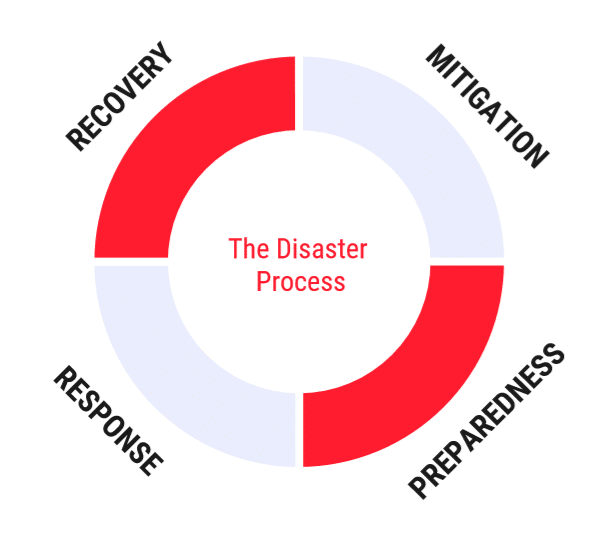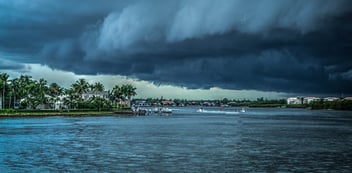Free Disaster Response Toolkit
Eli Samuels
There are four phases of any long term disaster recovery plan: mitigation, preparedness, response, and recovery.
During the mitigation phase of a long term recovery plan, disaster response organizations along with local government take steps to reduce the jurisdiction’s vulnerability to impact by a disaster. The preparedness phase focuses on understanding how different types of disasters will impact the jurisdiction and building capacity to respond to those disasters. Response to a disaster concentrates on reducing the loss of life and property by addressing immediate threats. Recovery begins during response and aims to return the disaster-impacted area to pre-disaster status.
Short Term and Long Term Disaster Recovery Plan
Recovery can be broken into two additional phases: short-term recovery and long-term recovery. Short-term recovery usually lasts less than six months and focuses on addressing the immediate needs following the emergency period. Short-term recovery includes activities such as restoration of critical functions and vital resources, damage assessment, debris removal, power restoration, and providing temporary housing.
The transition to long-term recovery is typically characterized by the completion of emergency programs and the return to daily life. This phase can last for months up to several years. The long-term recovery period focuses on restoring economic activity and rebuilding the community. The most important element of this phase is the everyday work completed to reduce the long-term risk to people and property.
How to Come up With Long Term Recovery Plans
A long term disaster recovery plan is much different than preparing for disaster response. Disaster recovery preparation involves identifying strategic restoration, improvement, and growth priorities. Each disaster is unique and the extent and type of damage will vary, which impacts long-term recovery. Planning for recovery should be done prior to a disaster along with mitigation planning and response preparation. It is important to develop a recovery plan prior to a disaster; one that establishes clear leadership, decision-making structures, and stakeholder involvement. This plan should also establish criteria for identifying redevelopment goals related to economic sustainability and growth, environmental factors, and historical preservation. This plan is really a guide for determining goals and priorities specific to any disaster that occurs. Once a disaster transitions into the recovery phase, businesses and government agencies are responsible for normal daily duties as well as the functions required by the recovery efforts. In addition, many of the external resources such as volunteers and donations begin to decrease. To coordinate long-term recovery activities and meet the needs of the community, some jurisdictions develop long-term recovery groups (LTRG).
Long-Term Recovery Groups
As described by National Voluntary Organizations Active in Disasters, a long-term recovery group (LTRG) is a cooperative body that is made up of representatives from faith-based, non-profit, government, business, and other organizations working within a community to assist individuals and families during disaster recovery. A well-organized LTRG increases the community’s ability to address unmet human and social recovery needs.
LTRGs ensure resources are used in the most efficient and effective ways to address community needs. They help make sure duplicate assistance is avoided, and they work to continue generating financial, material, and human resources for the duration of the recovery process. LTRGs provide assistance in many different ways. This assistance may include
connecting survivors to organizations that can provide food, clothing, mucking and gutting services, or grants for re-establishing a home. In addition, LTRGs spearhead other important work such as community education and policy promotion that will reduce the risk of harm during a disaster. The structure of each LTRG is unique to the community in which they operate. However, building a strong foundation is essential to any LTRG.
Tips for Establishing a LTRG
- Convene a meeting. This meeting should include potential partners and other stakeholders. Be sure to include formal and informal community leaders.
- Write a mission statement. This should be a short, descriptive statement that guides the LTRG in decision making and recovery practices.
- Determine an operating structure. Each LTRG is different and may be extremely structured or more informal. Regardless of the structure, it is important to have bylaws that describe how the LTRG will operate and work within the community.
- Gather information about the service area. This information should include basic demographics of the service area, the number of homes and businesses, and vulnerable populations within the service area.
- Develop policies. These policies should establish who the LTRG will help along with what services will be provided.
Regardless of the operating structure, each LTRG will identify unmet community needs, provide case management, and deliver resources to those in need.
In Conclusion
Each disaster is unique and so is the recovery effort. However, having a long term recovery plan in place and establishing long-term recovery groups can alleviate some of the challenges faced by communities during the aftermath of disaster.






